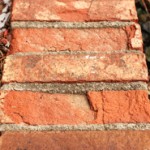 This photo shows spalling brick, another example of the damage freezing weather can inflict on masonry walls. Chimneys, masonry retaining walls and brick paving are all susceptible the ravages of frost action during the winter season. Areas to the far north actually fair better than those geographic locations located along the snow belt line across the country when it comes to spalling brick.
This photo shows spalling brick, another example of the damage freezing weather can inflict on masonry walls. Chimneys, masonry retaining walls and brick paving are all susceptible the ravages of frost action during the winter season. Areas to the far north actually fair better than those geographic locations located along the snow belt line across the country when it comes to spalling brick.
The reason is simple once you understand what is actually occurring during the freeze-thaw cycle. The primary culprit for spalling brick damage, as it is with most building materials, is excessive amounts of water or moisture entering into the masonry system prior to a freeze. As the water locked inside the pores of the masonry unit begin to freeze it starts turning to ice and expands.
This expansion, over a period of 100 or so cycles will eventually begin to break the masonry unit apart (spalling brick) by spitting apart the unit along the lines of the highest water saturation. At this point you should have the spalling brick repaired. Interestingly enough you would think that cities located in the far north would experience more damage than location further south.
The reality is that more spalling brick damage occurs along the snow belt line that runs across the country than in the colder areas in the north. The reason? Simply this; there are more freeze-thaw cycles in any given year. Northern location may begin to freeze in let’s say October but will stay frozen until the following spring thaw. Effectively you have 1 freeze thaw cycle.
Areas along the snow belt line are constantly fluctuating above and below freezing so the freezing action can occur up to 20 to 100 more times during a given winter thus causing more spalling brick damage than locations further to the north. Interesting isn’t it? If you have spalling brick that need to be repaired drop us an email. Contact Us






















